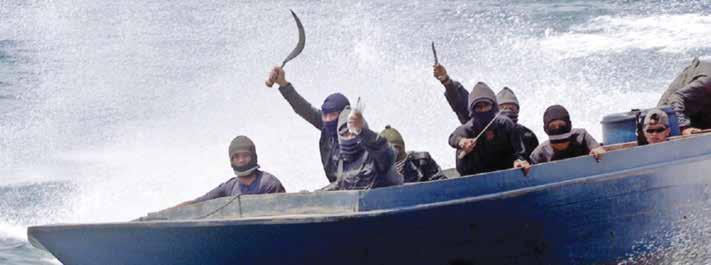
11 minute read
MILITARY
MARITIME SECURITY CHALLENGES AND FUTURE FORCE LEVEL DEVELOPMENT
A variety of factors, many beyond the scope of the maritime arena, will have a substantial effect on maritime security in the future. Most will neither be inherently asymmetrical nor conventional in nature, but will encompass elements of each. These forces are already at work today; indeed, many profoundly affecting the maritime security environment. In the future, some will retain their prominence and others will rise markedly in influence.
Advertisement
According to the United Nations, 41 percent of the world’s pirate attacks between 1995 and 2013 took place in the Malacca and Singapore straits From a maritime perspective, the sea is a source of prosperity and advancement. It acts as a medium for interaction between local, regional and global communities. Enormous amounts of goods have travelled by sea since time immemorial. There are over 23,000 ships underway everyday transporting about 95% of the world’s commerce and more than half of the world’s population resides within 100 km of a coastline. When maritime security communities speak about Sea Lines of Communication (SLOC) they refer to more than mere shipping routes. SLOC represent access to the renewable resources of the sea such as fishing stocks and natural resources that can be extracted from beneath it. We continue to be dependent on free and open access to the sea for our security and prosperity just as we did centuries ago. The difference is that today the sea has become a dangerous conduit for various actors who see the general lack of security and attention by many coastal states as an opportunity to exploit and impose their will. This trend is expected to continue well into the future.
Despite the absence of universally accepted definitions of “Regional Security”, the term in a Southeast Asia context relates to a significant degree to maritime security. Of the 10 ASEAN members, nine are coastal states and they include two of the world’s largest archipelagic states. Their reliance on maritime security was clearly demonstrated in August 2017 during the 50th ASEAN Foreign Minister’s Meeting held in Manila when the joint communiqué emphasized the need for “...strengthening linkages in maritime cooperation to further promote mutual trust and confidence to ensure security, peace and stability including ensuring the safety and freedom of navigation...”
Maritime security in its strictest and most traditional sense refers to protection from military threats via seaborne or naval operations carried out by adversary’s forces with the aim of seizing control over one’s seas. More contemporary and accepted definitions include security from the threat to coastal states or maritime communities from activities at sea such as piracy or armed robbery against ships, seaborne illicit trade or trafficking, intentional and unlawful damage to marine ecosystems or the environment such as discharging pollutants as well as illegal exploitation of maritime resources including those via illegal, unreported and unregulated fishing.
This gradual but significant shift in strategic priorities - away from a strict interpretation of maritime security as a purely militaristic endeavour will result in ever-increasing pressures on navies to develop the capabilities necessary to address a wider range of security challenges.
Collaboration and partnership in capacity building contributed to effective operations, build trust and manage risk Abu Sayyaf is the regional off-shoot of IS. It is one of several VEOs operating around the Sulu-Celebes Sea tri-border areas.

Some of the more pressing threats that are directly or indirectly linked to the maritime domain and has the potential to affect Malaysia’s security include:
1. Territorial Disputes and Maritime Claims
Overlapping and competing territorial and maritime claims continue to be a source of friction in our region. Actions to change established status quo and militarization of part of the disputed area have resulted in heightening tensions between claimants and other legitimate users of the seas. As our economic livelihood depended so much on the open and free uses of the sea, any attempt to control or restrict uses of Sea Lines of Communications could severely impact our economy and sovereignty. These challenges appear to be escalating and are unlikely to be resolved in the near future.
2. Terrorism and Violent Extremist Organizations (VEOs).
Threats posed to Malaysia by the self-proclaimed Islamic State (IS) and other VEOs have led to increased attention towards counter-terrorism efforts. Although Malaysia did not experience IS-related attacks since 2017 and the number of foreign terrorist fighters from Malaysia has decreased, we are still labelled as a source, transit, and to a lesser extent a destination country for suspected IS supporters. The March 2013 attacks on Lahad Datu and the five month siege of Marawi, Philippines in May 2017 demonstrated the type of capability that terrorists or VEOs are able to field within a short space of time. A range of extremist actors motivated by ideology, financial gain, clan ties, politics, or other reasons could result in other similar attacks with little or no warning.
3. Great Power Competition.
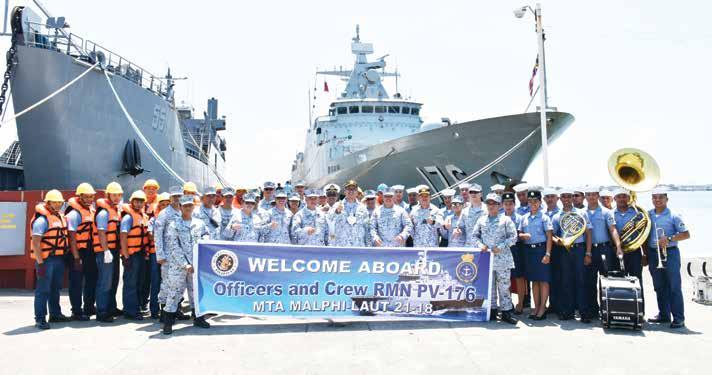
Rivalry, particularly between the world’s sole superpower and Asia’s rising power in this region is a source of concern. Although the probability of military conflict for the sake of gaining territory between the two powers is remote, their rivalry for dominant status and influence is equally dangerous. Brinkmanship, followed by a miscalculation by commanders on the ground could easily lead to conflict and destabilize the whole region. Malaysia has asked for a reduction in the presence of warship in the South China Sea as it sees it as being critical to preventing accidents and militarization and as having the potential to impede freedom of navigation.
4. Natural Disasters
Our region is the most disaster-prone region in the world. About 75 percent of the Earth’s volcanoes and 90 percent of earthquakes occur in the “Ring of Fire” surrounding the Pacific Basin where the majority of our neighbours are located and where we are adjacent to. According to a 2015 UN report, disasters over the last ten years took the lives of half a million people in the region with over 1.5 billon people affected and causing damages valued at more than USD 500 Billion. When natural disasters and humanitarian crises strike, communities are often devastated and left vulnerable, having little access to life’s essentials such as food, clean water, shelter and basic services.
When there is a disaster, an organized response to alleviate the consequence of a catastrophe is imperative. If the intensity of natural disasters result in severe humanitarian crises such as the one that struck Palu in Indonesia recently, a large scale disaster relief involving emergency response and restoration is necessary. In a maritime region like ours, large scale disaster relief can only be carried out effectively with the involvement of military assets, especially from a suitably equipped navy.
5. Transnational Crime. 7. Proliferation of Weapon of Mass Destruction
Transnational criminal organizations operating across borders are responsible for the majority of illicit activities and violence in this region. In this instance, technology is the enabler that disperses such organizations across borders, while vast local knowledge is used to hide their real activities, thus making effective targeting of these threats very challenging. The discreet and versatile nature of drug and human trafficking organizations, smugglers and kidnapfor-ransom by armed groups often enables them to commit crime without being detected. Our maritime border areas which are vast and difficult to patrol are particularly vulnerable to these threats.

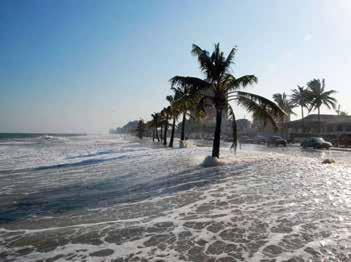
6. Cyber Security
Growing interconnectedness between digital and physical worlds and the increasing dependence on information technology have expanded the risk of cyber attacks in recent years. Geopolitical tensions further increases demand among state and non-state actors to collect confidential information, which in turn drive cyber espionage activities. The risk of cyber attacks particularly against critical infrastructure information (CII) systems such as those used in our ports and defense network is a major concern for Malaysia. Successful cyber attacks can degrade or disable CII systems and as a consequence disrupt essential services, undermine confidence in the national economy and affect safety and security. High-profile attacks such as the WannaCry ransomware attack in May 2017 disrupted livelihood in many countries, including Malaysia. Cyber attacks have become increasingly sophisticated and the trend is set to continue. Nuclear armament proliferation in several Asian countries is a major threat to regional security and stability. Countries with nuclear armament within this region have all increased their warhead inventories over the past several years, albeit in a muted manner. Malaysia along with other regional countries are particularly apprehensive when North Korea continues to carry out Intercontinental Ballistic Missile tests despite sanctions and having agreed not to do so. Elsewhere in South Asia, ongoing tensions between Pakistan and India remains a long standing challenge. The nuclear policies of both countries continue to be a significant source of concern for the region. The two states continue to develop and test nuclear weapons with land, sea and air-based missile delivery systems that possess the range that extends well beyond the sub-continent.
8. Climate Change
Average temperatures in Southeast Asia have been on the rise every decade since 1960. Asian Development Bank estimates that Southeast Asia would suffer a bigger loss compared to most of the other regions of the world. Left unchecked, climate change could potentially reduce 11% of the region’s GDP by the end of the century as it affects important sectors such as agriculture, tourism, fishing as well as health and labour productivity. As climate change accelerates it will also shape the region’s major strategic challenges. This includes a host of maritime security issues such as contested boundary delimitation when demarcation baseline changes, trans-national migrations as populations flock to greener pastures and illegal, unreported and unregulated fishing when established areas have depleted their stocks.
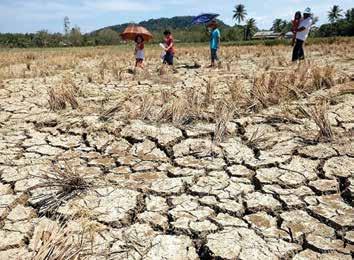
9. Food Security
Malaysia currently ranks 41 out of 113 countries on the Global Food Security Index. Although the Self Sufficiency Level is healthy, the trend may change in the future as our population increases and competition for food source intensifies. A vast majority of our food is either from the sea, or imported into the country via the sea. In the event of a conflict at seas that surround us or any other incidence that hampers our ability to extract food from the sea or impedes food supplies into Malaysia, we could face a severe shortage of food supplies.
10. Energy Security
Energy security is defined as “the uninterrupted availability of energy sources at an affordable price”. Long-term energy security is about timely investments that supply energy in line with economic developments and sustainable environmental needs, while short-term energy security focuses on the ability of the energy system to react promptly to sudden changes within the supplydemand balance. Energy security is thus linked to the negative economic and social impacts of either physical unavailability of energy or large, unreasonable price fluctuations. As Malaysia’s major source of energy is still petroleum based and almost all of which are located offshore, any disruption to the production, storage and distribution of those supplies can have a negative impact on the economy and our well-being.

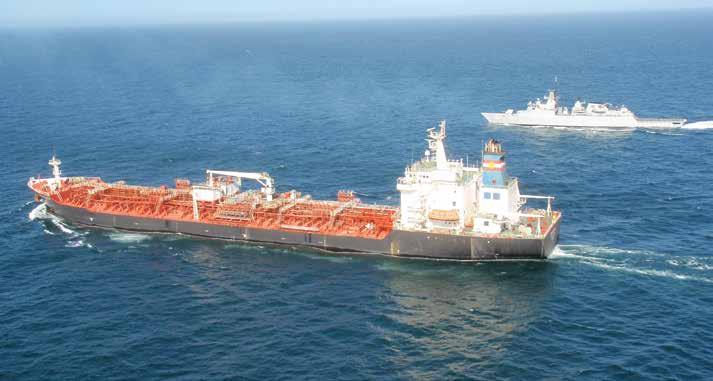
Protecting energy supplies and the means to transport them such as this operation in the Gulf of Aden are increasingly important task for RMN To address the challenges stated above, RMN must develop an appropriate force structure and capability that is credible, versatile and relevant to the needs of the country. This will enable the navy to stay ahead of both the traditional and non-traditional maritime security threats.
Designing a force structure cannot be effective unless directed towards clearly identified needs. While today’s needs are different from the past and may differ in the future, what is certain is that Malaysia requires a navy that possesses a diverse range of capability instead of one that is confined only to the realm of combat or fighting a high intensity conflict. Therefore our fleet or Armada as it is known in our Service, must be evenly prepared and our force structure be designed to be able to respond to different types of challenges; from providing assistance to civil community to responding to natural disasters and at the same time deter potential aggressors.
The high level technology and quality of the vessels within the Armada will be of little use if the “man behind the machine” and the relevant supporting elements are not performing at optimum level. To achieve this, RMN must adopt a more pragmatic strategy that not only focuses on recapitalizing the fleet, but also one that focuses on fielding a balanced Armada, while enhancing its enterprise processes, policies, structures and most importantly, its human capital. This will enable us to not only hone existing capabilities but also make necessary adjustments to meet the increasingly diverse challenges of the future.
As the largest and the only branch of maritime services in Malaysia that possesses the reach and the means to conduct persistent and out of area operations, the RMN is expected to continue to play an important role in addressing these security challenges either singularly or in cooperation with other maritime agencies. In short, RMN will need to balance its future force structure between one that is capable of fighting at sea, providing support and influencing events ashore as well as fulfilling other diplomatic and constabulary functions in an environment where Malaysia’s interests and Malaysian are becoming increasingly globalised.
First Steel Cutting Ceremony of RMN Littoral Mission Ship (LMS) in Wuhan, China. LMS will provide versatile yet low cost solution for Malaysia’s needs

